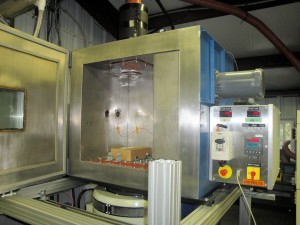DES recently performed qualification testing on aerospace connectors which involved combined temperature and sinusoidal vibration testing, random vibration testing and shock testing. Combined temperature and sinusoidal vibration tests were performed per EIA 364-28F. EIA 364-28F required test conditions of 10-2000 Hz, 20G maximum acceleration sweeps at temperatures of -54°C and 200°C over the course of 4 hours per axis. Random vibration tests were also performed per EIA 364-28F. Random vibrations at 50-2000 Hz, 46.3 Grms were applied to the connectors for 8 hours per axis. The random vibrations were applied at room temperature. Finally, the connectors were subjected half sine shocks per EIA 364-27C. The shock requirements were three shocks per polarity, per axis at 300G over the duration of 3msec. A sample shock plot can be seen in Figure 1.

Continue reading Qualification Testing on Aerospace Connectors →
